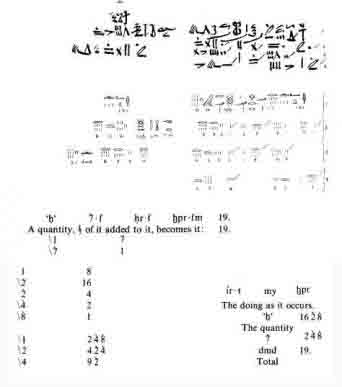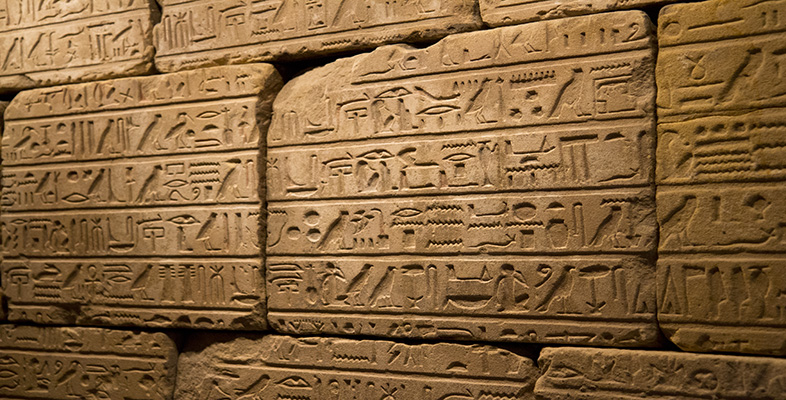1.1.1 The Rhind papyrus
For a literate civilisation extending over some 4000 years, that of the ancient Egyptians has left disappointingly little evidence of its mathematical attainments. Even though the classical Greeks believed mathematics to have been invented in Egypt – though their accounts are far from unanimous on how this happened – there are now but a handful of papyri and other objects to convey a sense of Egyptian mathematical activity. The largest and best preserved of these is the Rhind papyrus (Extract 1), now in the British Museum, a copy made in about 1650 BC of a text from two centuries earlier. In Box 3 the Egyptologist Sir Alan Gardiner explains an initially puzzling feature of Egyptian arithmetic, the Egyptian concept of fraction or part. The commentaries given in Box 4 are contrasting perceptions of Egyptian mathematics, from the translator of the Rhind papyrus and from a historian of mathematics.
Extract 1 Two problems from the Rhind papyrus
(a) Problem 24

(b) Problem 40

Question 1
Examine the extract from Chace's edition of the Rhind Papyrus, Extract 1(b), comparing it with the photograph shown in Figure 1. Try to work out what things the Egyptologist has done. Do you yet feel in a position to begin to understand what the Egyptian scribe was doing? (Do not worry if your answer to the last question is ‘no’!)
Discussion
You should have been able to notice, just from the look of the page, that it has three sections. The top one is a hand-written copy of the papyrus text itself, while the bottom section contains a rather literal English translation into our language and numerals. The middle section is a transcription of the text itself (which is written in a script called hieratic) into hieroglyphic, the standard script in which Egyptologists work, with an indication of the sounds and numeral values. (You may have noticed other features too, such as that hieroglyphic and the original hieratic-reads from right to left, so the ordering has been reversed in going from the middle to the bottom section.)
As to understanding the text, I would say that not only is the calculation of an unfamiliar kind — just what is going on there is far from clear – but also, even what the problem is has yet to be put in a form accessible to most of us.
If we were to work through the calculation, it would be possible to infer what the question was. ‘Loaves 100 for man 5, 1/7 of the 3 above to man 2 those below. What is the difference of share?’ seems to be saying that a hundred loaves are to be divided between five men in a particular way. This is that each is to receive a different number of loaves so that the two men who receive the least end up with a seventh of what the other three men get between them. Further, it requires that the difference between what they receive is constant: each man receives a fixed number of loaves more than the next man. (So the number of loaves each receives is in what we would call an arithmetical progression.)
You may observe that the scribe's way of putting the problem had at least the virtue of succinctness! We shall leave the actual calculation for now, and return to it once we have looked at the more general principles governing the ways Egyptians handled numbers, as inferred from the evidence of the Rhind and other papyri. As already mentioned, evidence from papyri extends over a long period, although it is rather scanty and is reinforced by evidence from only a few other artefacts, such as bits of pot, tiles and stone inscriptions. From the limited evidence we have, however, the fundamental spirit and mathematical approach of Egyptian mathematics seem to have changed very little over three millennia.
